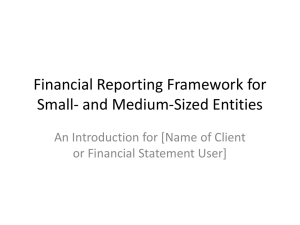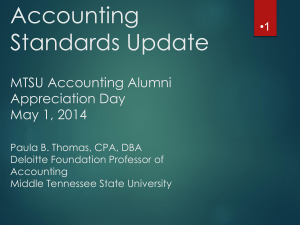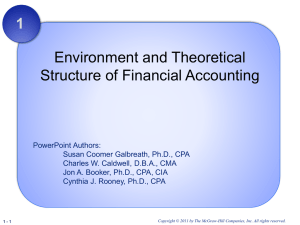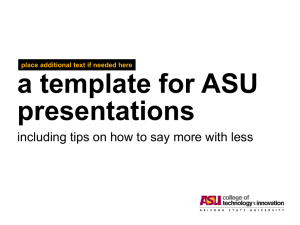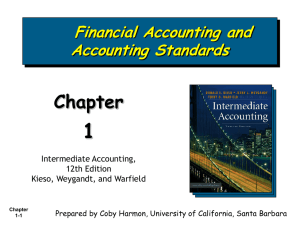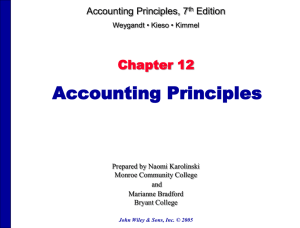Presentation - Accountants One
advertisement
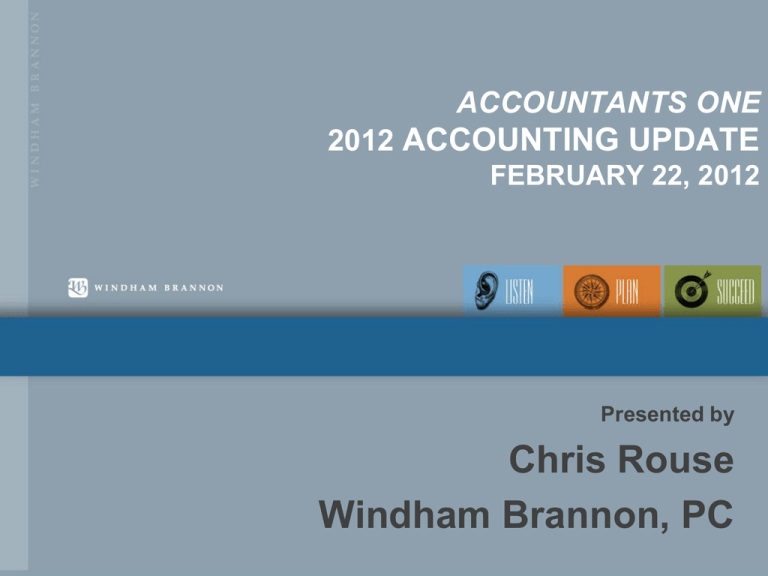
ACCOUNTANTS ONE 2012 ACCOUNTING UPDATE FEBRUARY 22, 2012 Presented by Chris Rouse Windham Brannon, PC 2012 ACCOUNTING UPDATE Topics To Be Covered • Questions, Questions, Questions oWhat’s going on at FASB? oWill IFRS be adopted? oWill all operating leases be capitalized? oWhen are we going to have “Little GAAP”? oWill the balance sheet still balance? oWhere have all the VIEs gone? oWhen is revenue “earned”? oWhat is equity? • Pot Pourri of Other New Standards 2 2012 ACCOUNTING UPDATE What’s Going On At FASB? • Board members Leslie Seidman (Chair) Industry Dir Acctg Policy & Stds (JP Morgan) Larry Smith Public Accounting Former EITF Chair (KPMG) Tom Linsmeier Education Derivatives Expertise (Michigan State) 3 2012 ACCOUNTING UPDATE What’s Going On At FASB? • Board members Russell Golden Public Accounting EITF Chair/FASB Staff (Deloitte & Touche) Marc Siegel Industry Forensic Accounting (RiskMetrics Group) 4 2012 ACCOUNTING UPDATE What’s Going On At FASB? • Board members Daryl Buck CFO, Private Company Blue Ribbon Panel Harold Schroeder Investment Manager EITF Member 5 2012 ACCOUNTING UPDATE Will IFRS be adopted, rendering all our GAAP accounting skills obsolete? • FASB continues to advance Convergence with international accounting standards o All recent FASB Standards reflect convergence with IFRS o FASB believes international standards are best for worldwide markets o Pressure for convergence is moving faster than FASB anticipated o Conceptual Framework focus is on private sector 6 2012 ACCOUNTING UPDATE Will IFRS be adopted, rendering all our GAAP accounting skills obsolete? • Uncertainty regarding completion of projects remaining on MOU • Both FASB and IASB have said there will be no future projects once current agenda is completed 7 2012 ACCOUNTING UPDATE Will IFRS be adopted? • In 2008, SEC proposed Roadmap for potential use of IFRS by US issuers beginning 2014 • In 2009, both SEC and Congress expressed concerns about progress on the Roadmap • In 2010, SEC said prior Roadmap timing is no longer in play – Work Plan adopted • In 2011, SEC said progress on Work Plan is slower than expected 8 2012 ACCOUNTING UPDATE Will IFRS be adopted? • SEC “Work Plan” examines 6 areas impacted by adoption of IFRS by US companies o Consistency of application o Independence of IASB o Investor understanding of IFRS o Impact on US laws and regulations o Impact on preparers o Impact on auditors 9 2012 ACCOUNTING UPDATE Will IFRS be adopted? • IASB has issued IFRS for Small and Mediumsized Entities (SMEs) o 230 pages, with separate illustrative financial statements and disclosure checklist o “Not exactly” IFRS or US GAAP o Plan to issue changes every 3 years 10 2012 ACCOUNTING UPDATE Will all operating leases get capitalized? Will the entire balance sheet become “fair valued”? • Overarching principle – A right to use o Leasing is a financing transaction o Recognize lease payment obligation and leased asset on balance sheet o Includes all leases of tangible assets, not just property leases Board is still considering software and inventory leases 11 o Existing leases would be recognized 2012 ACCOUNTING UPDATE Will all operating leases get capitalized? • Lessee accounting o Lease obligation recognized at present value Contingent payments that are likely to occur would be included Indexed changes would be recognized as they occur Lease term includes non-cancellable period plus renewal periods when “significant economic incentive” to renew is present Discount rate is rate charged by lessor or 12 lessee’s incremental borrowing rate 2012 ACCOUNTING UPDATE Will all operating leases get capitalized? • Lessee accounting o Lease asset recognized at obligation plus direct costs o Subsequent changes reflected as they occur In earnings if change arises from current or prior periods In obligation (and asset) if related to future periods 13 2012 ACCOUNTING UPDATE Will all operating leases get capitalized? • Lessee accounting o Financial statements Balance sheet, income statement and cash flow measurement and geography changes Disclosures Reconcile opening and closing asset and obligation, by class Undiscounted maturities for 5 years and thereafter, less interest portion 14 2012 ACCOUNTING UPDATE Will all operating leases get capitalized? • Lessee accounting o Disclosures Lease expense in tabular format, including Amortization Interest Variable payments not in amortization Expense for any non-capitalized leases Future commitment for services or non15 asset component of leases 2012 ACCOUNTING UPDATE Will all operating leases get capitalized? • Lessor accounting o A dual model Performance obligation approach for financing transactions De-recognition approach for sale transactions 16 2012 ACCOUNTING UPDATE Will all operating leases get capitalized? • Lessor accounting o Performance obligation approach Applies when lessor retains risks and rewards of asset Recognize asset for contractual terms, plus contingent rentals, renewals, termination payments, etc Changes as lease payments are made Recognize liability to provide asset Amortize based on pattern of use (revenue) 17 2012 ACCOUNTING UPDATE Will all operating leases get capitalized? • Lessor accounting o Performance obligation approach Recognize interest income using effective interest method Reassess estimates each reporting period Recognize changes in lease terms on balance sheet Changes in contingent/index payments added to asset and liability Included in current period revenue if effects 18 prior or current period 2012 ACCOUNTING UPDATE Will all operating leases get capitalized? • Lessor accounting o Performance obligation approach Leased asset remains on books Depreciation/amortization in accordance with GAAP 19 2012 ACCOUNTING UPDATE Will all operating leases get capitalized? • Lessor accounting o De-recognition approach When ownership transfers at end of lease, or when there is a bargain purchase option Recognize receivable and sale revenue De-recognize asset and recognize cost of sales Amount is based on relationship of fair values of receivable and asset Residual is not accreted While similar to current sales-type lease, 20 2012 ACCOUNTING UPDATE Will all operating leases get capitalized? • Lessor accounting o De-recognition approach Reassess upon change in lease terms Contingent/index cash flows are recognized in revenue On balance sheet, present lease receivable separately from other financial assets 21 2012 ACCOUNTING UPDATE Will all operating leases get capitalized? • Lessor accounting o De-recognition approach Any residual asset is presented separately within that asset’s class Income statement depends on lessor’s business Financing business – net lease income and expense on one line Seller business – separate lines for lease income and expense 22 2012 ACCOUNTING UPDATE Will all operating leases get capitalized? • Sale- Leasebacks o o o Recognized as two transactions “Control” criteria in revenue recognition ED would determine if sale occurred Accounted for as (1) sale of “whole” asset, and (2) lease of a right-to-use underlying asset 23 2012 ACCOUNTING UPDATE Will all operating leases get capitalized? • The Devil is in the details o Second exposure draft due out “soon” Some key lessor items still being discussed Second ED may still have some tentative positions Preparing financial statement preparers Preparing auditors Preparing financial statement users o o o 24 2012 ACCOUNTING UPDATE When are we going to have “Little GAAP” for smaller companies? • FASB is considering GAAP Differences vs. Separate GAAP approach o Criteria considers different user needs Differences in user access to information Cost/Benefit considerations Small/Large business vs. Public/Nonpublic business Note – FASB does not believe there is a lack of investor users for non-public entities • FASB has named a staff-member to oversee 25 all nonpublic entity issues 2012 ACCOUNTING UPDATE When are we going to have “Little GAAP”? • Small Business Advisory Committee formed in 2004 o Purpose is to obtain more active involvement by the business community in accounting standards Representatives include public and nonpublic companies o Twenty members representing users, preparers and auditors o Meets twice a year, discusses issues and submits recommendations to the Board 26 2012 ACCOUNTING UPDATE When are we going to have “Little GAAP”? • Private Company Financial Reporting Committee started in 2007 o Joint initiative of FASB and AICPA o Purpose is to provide recommendations to FASB on accounting standards for privately held companies 27 2012 ACCOUNTING UPDATE When are we going to have “Little GAAP”? • Private Company Financial Reporting Committee o Has submitted over 40 recommendations on specific standards eg, has issues with revenue from contracts exposure draft eg, is supportive of the lease accounting exposure draft Says FASB continues to show an unwillingness to consider and approve measurement, recognition or presentation 28 differences 2012 ACCOUNTING UPDATE When are we going to have “Little GAAP”? • Blue Ribbon Panel on Private Company Accounting formed in 2010 o Joint initiative of AICPA and FAF o Purpose is to address how accounting standards can best meet the needs of users of private company financial statements Lack of relevance for many users of private company financials Overall complexity concerns private company preparers 29 2012 ACCOUNTING UPDATE When are we going to have “Little GAAP”? • Blue Ribbon Panel on Private Company Accounting oRecommended near-term exceptions and modifications to US GAAP for private companies rather than a separate, selfcontained GAAP for private companies Recommended a separate private company accounting standards board to address both existing and new standards 30 2012 ACCOUNTING UPDATE When are we going to have “Little GAAP”? • Blue Ribbon Panel on Private Company Accounting oReport submitted in January 2011 – see it at http://www.accountingfoundation.org • In late 2011, the FAF rejected the Panel’s recommendation in favor of increasing FASB staff and input to FASB from non-public entity groups • AICPA has asked FAF to reconsider separate standard setting body for non-public entities 31 2012 ACCOUNTING UPDATE Will the balance sheet still balance? • FASB Project; Financial Statement Presentation o Tentative conclusion is a full set of financial statements is comparative information for two full years, consisting of statements of: 3 years of financial position 2 years of earnings and comprehensive income 2 years of cash flows 2 years of changes in equity 32 2012 ACCOUNTING UPDATE Will the balance sheet still balance? • FASB Project; Financial Statement Presentation o All statements would classify accounts as operating (business), financing and investing Format is similar to current cash flow statement See examples in Attachments 33 2012 ACCOUNTING UPDATE Where have all the VIE’s gone? • Improving VIE disclosures – ASU 2009-17 et al o Redefines primary beneficiary in qualitative manner The Power to direct the activities of the VIE that significantly impacts the VIE’s economic performance “Power” relates to management, not governance 34 2012 ACCOUNTING UPDATE Where have all the VIE’s gone? • Improving VIE disclosures o Redefines primary beneficiary in qualitative manner (cont) The obligation to absorb losses or receive benefits that could be potentially significant to the VIE Also assess whether the PB has implicit financial responsibility to ensure the VIE operates as designed Requires ongoing re-assessment of whether entity is PB of VIE 35 2012 ACCOUNTING UPDATE Where have all the VIE’s gone? • Related party “trap” still in play o“… in determining the primary beneficiary, a variable interest holder will consider its related party interests as its own” oTie Breaker rule says the Primary Beneficiary is the entity that is most closely associated with the VIE 36 2012 ACCOUNTING UPDATE Where have all the VIE’s gone? • Disclosures about cash flows, financial position and performance o How they are accounted for o Fair values in tabular form o Balance sheet and income statement locations o Notional amounts of derivative instruments 37 2012 ACCOUNTING UPDATE Where have all the VIE’s gone? • Disclosures about cash flows, financial position and performance o How they affect financial position, financial performance and cash flows Existence and nature of contingent features Timing and likelihood Cash effects Credit risk related contingencies Potential effect on liquidity o Additional disclosures required to increase transparency of PB’s involvement with VIEs 38 2012 ACCOUNTING UPDATE Where have all the VIE’s gone? • The Devil Is In The Details o Disclosures significantly exceeds those for entities consolidated because of majority ownership o Determining whether an entity is a VIE is a complex process and should not be undertaken “off the top of your head” o Determining who is the PB is a complex process and … • Effective for years ending after 11-15-10, and interim periods within that year 39 2012 ACCOUNTING UPDATE When is Revenue “Earned”? • Overarching Principles in Current Standards o Persuasive evidence of an arrangement exists Documentation required The fee is fixed or determinable No clear definition, but several examples Overarching principle – Cannot be dependent on future events o 40 2012 ACCOUNTING UPDATE When is Revenue “Earned”? • Overarching Principles in Current Standards o Delivery or performance has occurred Identifiable deliverables Seller has fulfilled obligation Proportional performance deliverables recognized Collectability is reasonably assured Determined at time of revenue recognition Factors for determining bad debt reserves are applicable 41 o 2012 ACCOUNTING UPDATE When is Revenue “Earned”? • Revenue recognition; Milestone method (ASU 2010-17) o Applies only to R&D vendors o Applies to payments earned upon achievement of milestones o In the absence of specific relevant GAAP, provides good accounting concepts for projecttype services 42 2012 ACCOUNTING UPDATE When is Revenue “Earned”? • Revenue recognition; Revenue arrangements that include software (ASU 2009-14) o Changed prior GAAP for recognizing revenue for sales of tangible products that include software essential to the functionality of the tangible product Clarifies what guidance should be used to measure revenue for product and software, not when to recognize it Includes revenue recognition for post-contract services and undelivered software 43 2012 ACCOUNTING UPDATE When is Revenue “Earned”? • Revenue recognition; Multiple deliverables (ASU 2009-13) o Divide arrangements into separate units and recognize revenue based on relative selling prices o Selling prices are determined using vendorspecific objective evidence o Effective beginning after 6-15-2010 44 2012 ACCOUNTING UPDATE When is Revenue “Earned”? • Revenue recognition exposure draft o Uses “contract” basis “Contract” is an understanding, and does not have to be in writing Identify rights and obligations of contracts with customers Determine transaction price(s) Allocate transaction price to performance obligations Recognize revenue when performance 45 obligation is satisfied 2012 ACCOUNTING UPDATE When is Revenue “Earned”? • Revenue recognition exposure draft o Performance obligations Single performance obligation if entity integrates goods or services into a single item Accounted for as multiple performance obligations if pattern of transfer is different for different goods or services, and … Each good or service has a distinct function 46 2012 ACCOUNTING UPDATE When is Revenue “Earned”? • Revenue recognition exposure draft o Measurement Multiple obligations would be measured on basis of relative standalone selling prices of the goods or services Next steps Re-expose a revised draft (imminent) Comment period 60-90 days Final standard in summer 2012 Effective date periods after 12-15-?? 47 o 2012 ACCOUNTING UPDATE What is “Equity”? • Financial Instruments with Characteristics of Equity o Basic ownership approach Only the most residual claim would be equity Approach preferred by FASB Currently the approach used in International Financial Reporting Standards o Ownership-Settlement approach Adds Perpetual and Indirect Ownership Interests to Basic Ownership Interests in equity 48 2012 ACCOUNTING UPDATE What is “Equity”? • Financial Instruments with Characteristics of Equity o Reassessed Expected Outcomes approach Would include instruments that change in fair value with changes in Basic Ownership instruments 49 2012 ACCOUNTING UPDATE Pot Pourri • Loans in 401(k) plans (ASU 2010-25) o Participant loans in 401(k) plans are not investments and will be carried at unpaid principal balance plus accrued interest o Effective for 2010 financial statements 50 2012 ACCOUNTING UPDATE Pot Pourri • Disclosures about credit quality (ASU 2010-20) o Applies to financing receivables Does not apply to trade receivables due in less than one year, or financing receivables carried at fair value 51 2012 ACCOUNTING UPDATE Pot Pourri • Disclosures about credit quality (ASU 2010-20) o Purpose is to improve user information about credit quality Nature of credit risk inherent in portfolio How credit risk is analyzed and assessed in determining the allowance for credit losses Changes, and their reasons, in allowances Many new disclosures o Effective for issuers 12-15-10, and for nonissuers 12-15-11 52 2012 ACCOUNTING UPDATE Pot Pourri • Improving fair value disclosures (ASU 2010-06) o Users requested greater level of disaggregated information and more robust disclosures Disclose separately amounts of significant transfers in and out of Levels 1 and 2, including reasons For Level 3, disclose separately information about purchases, sales, issuances and settlements (ie, gross, not net) 53 2012 ACCOUNTING UPDATE Pot Pourri • Improving fair value disclosures (ASU 2010-06) o Provide fair value measurement disclosures for each class of assets and liabilities carried at fair value Recognizes that judgment is required – consider user needs o Disclosure of valuation technique for Level 2 increased Separately for “similar” vs “identical” 54 2012 ACCOUNTING UPDATE Pot Pourri • Additional Fair Value Disclosures – ASU 2011-04 o Part of Convergence project – not many changes, and they are not significant o Clarifies that blockage factor is not appropriate, but control premium “may” be appropriate 55 2012 ACCOUNTING UPDATE Pot Pourri • Additional Fair Value Disclosures o Additional level 3 disclosures Valuation process used Sensitivity information Fair value categories for items not measured at fair value but for which fair value is disclosed 56 2012 ACCOUNTING UPDATE Pot Pourri • • Consider user needs when preparing fair value disclosures o Creditor needs are different than investor needs – cover both o Level 2 – comparable/active, or identical/inactive o Level 3 – Describe key assumptions and estimates Use a Great disclosure checklist o FASB ASC 820-10-50; Fair Value Disclosures 57 2012 ACCOUNTING UPDATE Pot Pourri • Fair Value of Private Investment Partnerships (ASU 2009-12) o Applies to investments in entities that permit redemption at specified times at net asset value determined using fair value accounting o Provides guidance as to how to use reported net asset value in determining fair value o Would be classified as Level 2; Identical security in inactive market Disclose observable and unobservable data 58 2012 ACCOUNTING UPDATE Pot Pourri • Other Comprehensive Income (ASU 2011-05) o Required to be on income statement or separate statement Re-title Statement of Income to Statement of Comprehensive Income o Effective years beginning after 12-15-2011 for publics, and 12-15-2012 for non-publics o Board has tweaked reclassification adjustment provisions in ASU 2011-12 59 2012 ACCOUNTING UPDATE Pot Pourri • Some on Healthcare Entities o Display and disclosure of revenue and bad debts (ASU 2011-07) o Gross up malpractice insurance claims and recoveries (2010-24) o Measuring charity care (at cost)-(2010-23) 60 2012 ACCOUNTING UPDATE Pot Pourri • More on financial instruments o Disclosure of gross information about assets and liabilities that have been offset (2011-11) o Credit quality of financing receivables (201020) o Loan pool modifications (2010-18) o Troubled debt restructurings (2011-02) 61 2012 ACCOUNTING UPDATE Pot Pourri • A couple on goodwill and other intangibles o Making qualitative assessment of goodwill impairment (ASU 2011-08) Annually consider whether it is more likely than not that goodwill fair value is less than carrying amount Negative change in economic conditions Negative change in financial performance 62 2012 ACCOUNTING UPDATE Pot Pourri • A couple on goodwill and other intangibles o Making qualitative assessment … (cont) Annually consider … (cont) Negative change in management, personnel, customers, etc Others listed If qualitative assessment “passes”, no need to perform 2-step test o 63 2012 ACCOUNTING UPDATE Pot Pourri • Goodwill o Testing goodwill impairment when investment is negative (ASU 2010-28) When carrying value is negative, presumably fair value exceeds carrying amount, so technically the impairment test is not called for Revised Standard requires a Step 2 test of goodwill impairment, which may result in additional negative investment Note previous discussion of ASU 2011-08 64 2012 ACCOUNTING UPDATE Pot Pourri • Complete listing of Accounting Standards Updates for 2012 – 2010 in Exhibit to slide deck o 2012; None issued at 2/15/2012 o 2011; # 01 – 12 o 2010; # 01 – 29 o 2009; # 01 – 17 • Visit http://www.fasb.org/jsp/FASB/Page/Section Page&cid=1176156316498 65 2012 ACCOUNTING UPDATE In Conclusion… • Monitor the FASB web site (www.fasb.org) • Monitor the AICPA web site (www.aicpa.org) • Call Chris Rouse at Windham Brannon 404-898-2000 Bon Auditpetite! 66

